|
|
Dancing, drama, music: pageantry so abounds this season that you’re likely to need some help choosing your pleasures. Read on; then make your reservations.
Most Chesapeake families celebrate Christmas. We wrap holly around everything and wait with fresh and bated breath beneath the mistletoe. We burn big logs in the fireplace and give our grandmas potted poinsettias. We wrap up the fruitcakes we got last year and pass them on to unsuspecting friends and family. We hang oversized socks over the fireplace if we have one, or pin them to the wall if we don’t.
 |
Arleene Monahan's Maryland Ballet Theatre rehearses its rendition of Nutcracker.
photo by Rebecca McClay |
Most of us celebrate Christmas, but we all celebrate it a little differently. We all decorate evergreen trees, but some prefer pines to firs. Some cook a turkey, some cook a goose and some a slab of tofu. Some go to church on Christmas eve, some Christmas morning, some not at all. Some set up tiny figurines representing baby Jesus and his family; some stand on the side of the road wrapped in old blankets as part in a living nativity. We take our kids to see Santa Claus, or we play Santa ourselves. We set out cookies and milk on Christmas Eve, and some of us add a few carrots for Santa’s reindeer.
Christmas pageants are likewise all a little different. Each year we witness a half dozen productions of Messiah, The Nutcracker and A Christmas Carol, but each production is a little different from the next. We hear a half dozen concerts featuring the same songs about drummer boys and merry gentlemen and little towns called Bethlehem and reindeer named Rudolf and angels and bells and silent, holy nights. But those songs are all sung a little differently, depending on who’s doing the singing.
Three Nutcrackers
Each dance troupe interprets the beloved tale with a splash of their own flavor
by Rebecca McClay
As the traditional Christmas ballet story goes, Clara’s nutcracker soldier, her favorite present, magically comes to life in the middle of the night. In a dancing duel, the Nutcracker and his toy doll troops defend Clara from a gang of mice before she dances with her hero. The dramatic fighting scene, the climax of the performance, keeps children at the edge of their seats, while the romantic duo’s dance mesmerizes adults.
 |
Ballet Theatre of Maryland director Leslie Bradley guides a dancer in rehearsal for Nutcracker.
photo by Norbert duBois
|
This year, Nutcracker performances from the Ballet Theatre of Maryland, Chesapeake Ballet Company and The Maryland Ballet Theatre grace area stages throughout December. Each interprets the beloved tale with a splash of its own flavor.
“What sets us apart from most is that we are dancing to a full orchestra to music that is so well known and equated with this holiday,” said Ballet Theatre of Maryland’s Nutcracker director Leslie Bradley. A lifetime dancer, she is now filling the shoes of the company’s founding director, Edward Stewart, who died earlier this year. This performance continues Stewart’s tradition of unique choreography and interpretation, which scripts Clara to dance the difficult Sugar Plum Fairy scene.
The Ballet Theatre of Maryland dancers — among them women from Russia, China and all over North America — whizzed through six weeks of five-day-a-week rehearsals under Bradley’s sharp eyes.
“I’m hoping everything still looks wonderful when they’re on stage,” said Bradley before the first performance. “I’m still in the throes of it. I won’t be able to realize it until it’s all over.”
The Ballet Theatre of Maryland dances at 8pm December 6; 2pm and 8pm December 7; 3pm; December 8; 2pm December 14 at Maryland Hall for the Creative Arts, 801 Chase Street, Annapolis. $26-41; rsvp: 410/263-8289.
The Ballet Theatre of Maryland’s Nutcracker at Maryland Hall is our region’s only professional Nutcracker performance, but directors of Crofton-based Maryland Ballet Theatre and Calvert County’s Chesapeake Ballet Company say their young students practice and perform at a professional level.
 |
At Chesapeake Ballet Company, Chinese girl Christine Judge rehearses Nutcracker as Chinese boys watch in amazement.
photo courtesy of Chesapeake Ballet Company
|
Abigail Francisco’s Chesapeake Ballet Company dancers rehearse in a glowing cottage-style dance studio on Chesapeake Bay in North Beach. On practice nights, the studio’s lobby — as quiet as a doctor’s waiting room — is filled with fidgeting brothers and patient mothers and fathers. But a short stretch of hallway leads to a backroom of carnival-like chaos.
In a late rehearsal, a door opens to a thundering Tchaikovsky symphony, snuffing out the silence. Giant gray mouse heads with twinkling ruby eyes and tiny pink legs dance wildly in unison as focused soldiers march in formation with toy guns.
“Something new is going on all the time,” said company dancer Erin Cooper, 17, who will play multiple parts in the production. “By the end of it, your adrenaline’s really going.”
Since September, the 45 dancers have been energetically drilling to the steps of Francisco choreography three times a week.
Chesapeake Ballet Dances at 7:30pm December 7; 2pm December 8 at Mary Harrison Cultural Arts Center, Northern High School, Owings. $15-25 with discounts; rsvp: 301/855-0282.
Meanwhile, in a studio tucked in a Crofton plaza, Arleene Monahan’s cast of the Maryland Ballet Theatre Academy steadily perfect their own version of the Nutcracker. Monahan, a petite woman with soft red hair and a confident gait, strolls through the aisles of her pink soldiers, looking each in the eye with a grin as she adjusts their heads.
“These girls may already be dreaming of the role they want to play next year,” Monahan said. Nutcracker dancers are her students, who auditioned in September without the pressure of a cut-list. Instead, every dancer was assigned a role based on a score given by four judges. The dancer with the highest score was awarded the role of Clara.
“I’ve always wanted to play Clara,” said 13-year-old Alice Burns, whose 10 years of ballet include nine Nutcracker performances. Burns is accompanied on stage by her whole family: brother Matt, 16, plays the Nutcracker, and her parents play the two leading adult roles.
“It’s fun to see your family smiling at you on-stage,” Burns said. She and 84 other dancers, ages three to 17, and a handful of parents have been practicing since early September in segmented rehearsals. Monahan’s goal was to minimize stress and anxiety, a goal she says may only be achieved after the first performance.
“My philosophy is that you must be comfortable performing, though that doesn’t mean it’s easy,” she said. “The enjoyment that you get is being able to take all your hard work and demonstrate it.”
She views the annual Nutcracker performance as a young girl’s dream come true, but also as a means to a future as a professional dancer.
Monahan, whose mind and muscles were once trained to Tchaikovsky’s score, has stitched pieces of her own childhood performances into the choreography of her Nutcracker. She has added several subtle touches (which we won’t reveal) that foreshadow dances.
Tchaikovsky’s music, known for its wide range of emotions, emphasizes Clara’s feelings, from her fear of the mice to her love of the Nutcracker.
“Music drives a dancer,” Monahan said. “There’s a variety of roles from strong, commanding, furious music to the Waltz of the Flowers, which is very soft.”
The Maryland Ballet Theatre Academy opened this season’s pageantry, performing at South River High School November 29 thru December 1.
Three Christmas Carols
Three different Christmas Carols, all musicals, shed warmth on the season
by April Falcon Doss
When Charles Dickens first led me through Scrooge’s journey, I was 17, but not too young to reflect on selfishness and on the glorious possibility that one could always — always — change course.
For most of us, Christmas without Scrooge’s lesson is as hard to imagine as Christmas without festive reminders of the generosity and hope that vitalize even the most secular celebrations.
There was no such Christmas fanfare in 1843, when Charles Dickens wrote his now-classic A Christmas Carol. Nearly all traces of Christmas bounty had been erased from England by dour Puritans, alarmed by the holiday’s pagan roots, and by the harsh demands of 19th century industrialization.
Into a stark environment Charles Dickens launched the slim novel he called A Christmas Carol, a story that depicted the rich bounty of country Christmases and exalted generosity and kindness above profit-seeking and greed. The story has been adapted countless times now, even to Disney versions featuring Donald Duck as Scrooge. Despite its cultural currency, it’s a story still able to make our hearts rise.
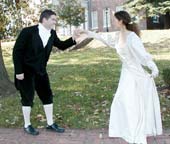 |
A young Scrooge, played by Dean Davis, dances with Belle, the love of his life, played by Najeda Patolo in Colonial Players’ A Christmas Carol.
photo courtesy of Colonial Players
|
Just before Christmas, Scrooge is visited by the ghost of his dead partner, Jacob Marley. Marley, who is doomed to wear the chains of his selfishness through all eternity, warns that Scrooge will, too. Scrooge is next visited by three spirits, the Ghosts of Christmas Past, Present and Future.
This being Christmas, there’s a happy ending of course: Scrooge repents and bursts forth to spread the love of Christmas among those who need it the most. It’s an unashamedly sentimental tale likely to bring tears even to eyes glazed over from browsing countless catalogues and to restore spirits deadened by too many trips to the mall. No wonder, then, that Dickens has been called “the man who discovered Christmas.”
Colonial Players in Annapolis offers Chesapeake Country’s oldest continuously running production of A Christmas Carol. This season marks the 21st year of a production with uniquely Annapolitan roots.
“Two of the men who wrote this adaptation were Colonial Players people, part of our family in a sense. It was written kind of for us,” explains director Judy Wobensmith. Richard Wade wrote the book and lyrics, and Dick Gessner composed the music. Both had acted and directed at Colonial Players before collaborating on the Dickens tale; Gessner now lives in Florida, but Wade is still involved with Colonial Players. His daughter is a caroler in this year’s production.
There’s plenty more tradition here. Costumes and sets evoke 1840s’ England. Many in the cast are traditions, too, like Ed Wintermute, playing the Ghost of Christmas Present, who has appeared in every production since its 1981 debut. The 30-person cast will storm through 16 performances in two weekends. Like the transformed Scrooge, Colonial Players uses the tale to express its own Christmas spirit: a portion of the low $6 ticket price is donated to the city of Annapolis.
8pm December 5, 7, 12, 14; 7pm and 9pm December 6 and 13; 2pm and 4pm December 7, 8, 14, 15; at Colonial Players, 108 East Street, Annapolis. $6 with discounts: 410/268-7373.
Chesapeake Music Hall’s dinner-theater Christmas Carol is written by the same team of Harnick and LeGrand, who are responsible for Fiddler on the Roof. The cast of 15 includes a number of Chesapeake Music Hall regulars, including some seen in the dinner theater’s Fiddler.
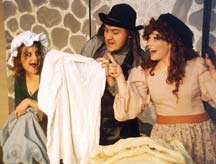 |
In Christmas Future, rag-pickers sort through Scrooge’s clothes. From left Santina Maiolatesi, Tim Grieb and Mary Armour-Kaiser.
photo courtesy of Chesapeake Music Hall
|
A special delight of this production, says director Sherry Kay, is the way such seasoned performers as Alan Hoffman, Scrooge for a second year, and Mary Armour-Kaiser add new nuances to their roles. Other regulars include Ronnie Schronce and Katy Smith.
“Our show is traditional,” says Kay, with period costumes and set design. “But with just enough of the modern-day to make it humorous. And the songs are very melodic, very hummable. People just leave the theater singing them.”
There’ll be snow on stage, cranberry sauce and stuffing at the buffet and plenty of the bounty of Christmas present.
Matinee performances Sunday and Wednesday with evening performances Thursday thru Saturday thru December 26 at Chesapeake Music Hall, 339 Busch’s Frontage Road, Annapolis. $33.50 Friday, Saturday; $30 Thursday, Sunday, Wednesday: 800/406-0306.
Chesapeake Center for the Creative Arts’ Carol is sure to be the most faithful to the original. With music by Doug Yetter and lyrics by local playwright and director Michael Hulett, the book for the play was written by none other than Charles Dickens.
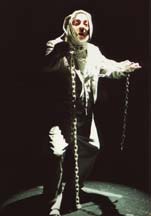 |
The ghost of Marley, Ron Sarro, warns Scrooge to change his ways.
photo courtesy of Chesapeake Center for the Arts
|
Hulett explains, “When Doug and I went about writing the play for the 150th anniversary of the book, we wanted to be very faithful to the original. So all the dialogue comes straight from the book. We haven’t changed a word.”
Likewise, he explains, the songs are precipitated by the action of the play. So, where Dickens has his characters playing a “Yes or No” riddle game in the original book, Yetter and Hulett devised a song called “Yes or No.” Marley’s song begins with Marley’s dialogue from the book.
For the original language, the play is as accessible to children as to adults: “Even if they don’t understand all the words, they understand the story,” says Hulett. That’s because its appeal is universal: “It’s kind of like a pilgrimage we make, to watch the show each year. We take the journey with Scrooge.”
It’s a proven combination. Since the play opened off Broadway, it’s been played dozens of times with good reviews. Last year marked the show’s debut at Chesapeake Center, and Hulett hopes to see it become an annual tradition.
8pm Friday and Saturday, 3pm Saturday and Sunday, December 6 thru 22 at Chesapeake Center for Creative Arts, Brooklyn Park. $15 with discounts; rsvp: 410/636-6597 • www.chesapeakearts.org.
I’ve reread A Christmas Carol at Christmas each year since I discovered it. Each year Scrooge’s journey reminds me of my own blessings. This season, discover or renew the spirit of the season with one of Chesapeake Country’s three musical adaptations of Charles Dickens’ classic A Christmas Carol.
And God bless us everyone.
The Music of Christmas
Music warms the soul like hot apple cider — sometimes plain, sometimes spiced.
by Brent Seabrook
After weeks of shopping for gifts, taking the kids to get pictures with Santa and finding a Christmas tree that won’t bankrupt you, it’s nice to relax at home, surrounded by family and friends. That’s exactly how Carolyn Surrick feels about returning to Annapolis, after weeks on the road performing with Ensemble Galilei.
Ensemble Galilei
“There’s nothing like coming back,” Surrick says. “It’s so relaxed, and we can just be us.”
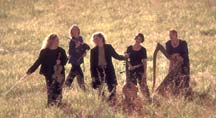 |
Ensemble Galilei celebrates the holidays and winter solstice with its own ‘chamber folk.’
photo courtesy of Ensemble Galilei
|
Ensemble Galilei is five women who play an eclectic assortment of instruments — Liz Knowles on fiddle and viola, Deborah Nuse on fiddle and Scottish small pipes (miniature bagpipes), Sue Richards on Celtic harp, Carolyn Surrick on viol de gamba (a sort of archaic cello) and Sarah Weiner on oboe, tin whistle and recorder — plus Kiernan O’Hare on Uilleann pipes (similar to small pipes), flutes and whistles.
Individually, the musicians are no slouches. Richards is a four-time national Scottish harp champion; Knowles was the featured fiddler on the Michael Collins soundtrack and toured with Riverdance. But together they make magic, weaving the vitality of folk music into complex chamber arrangements to create a unique tapestry of sound they call “chamber folk.”
For 12 years, the ensemble has celebrated the season with a concert at St. Johns College Great Hall, followed by a candlelit reception for audiences to meet the musicians.
“It started in 1990,” Surrick says. “A gathering of people in the Great Hall — of family and friends — for a celebration of the holiday, of the winter solstice, of music and of all of the things we love about Christmas in a small town. Every year, the musicians stand backstage listening to the chatter of the audience. Actually it’s a roar. It’s the sound of community, of people standing in the aisles catching up with old friends, of laughter and stories being told.”
When the audience finally settles, the music begins. But not the usual Christmas carols.
The songs the ensemble plays aren’t always unusual, either. Every concert, Surrick says, features a mix of “some music people know, some they don’t know,” including Celtic carols from Galicia, Spain, Scotland and Ireland, Medieval and Renaissance dance tunes and original compositions to mark the winter solstice. There are also such Christmas classics as “What Child is This,” “I Saw Three Ships,” “The First Noel,” “Joy to the World” and “Christmas Day in the Morning.” Even well-worn songs have fresh polish.
“We’ve been known to take familiar tunes and make them our own,” Surrick says.
Promised this year is a “dark and slow and delicious” rendition of “God Rest Ye Merry Gentlemen,” plus “a twisted version of ‘I Wonder As I Wander’ and a beautiful Irish tune called ‘Easter Snow’.” You’ll also hear Neal Conan, host of National Public Radio’s Talk of the Nation.
“Neal’s sort of a fan and a pal of ours,” Surrick says. “He’s gonna be reading poetry, and some isn’t holiday.”
Think Jim Harrison’s “February Swans” and Ogden Nash’s “The Party Next Door.” Surrick predicts “there’s gonna be some part of the Nutcracker” played behind the Nash poem, but played as if by drunken revelers.
For Ensemble Galilei, breaking with tradition has become a holiday ritual.
Neal Conan joins Ensemble Galilei at Music in the Great Hall’s 13th annual Winter Solstice/Christmas Celebration, 8pm December 13; 3pm and 8pm December 14 at McDowell Hall, St. Johns College, Annapolis. $20; students and seniors $16: 410/849-2494.
Annapolis Symphony Orchestra
It isn’t Ensemble Galilei, but anyone who expects a staid performance from the Annapolis Symphony Orchestra is in for a surprise.
“At last year’s Holiday Pops, we did a song called ‘The Twelve Days After Christmas,’ ” says the orchestra’s marketing manager, Lauren Kirby.
Putting a playful twist on a familiar favorite has become a symphony staple. “On pops programs, finding unique arrangements is par for the course,” Kirby says.
 |
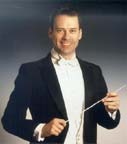 |
Soprano Wendi Washington-Hunt joins guest conductor Robert Moody for Annapolis Symphony Orchestra’s Holiday Pops this year.
photos courtesy of Annapolis Symphony Orchestra
|
Holiday tunes, perhaps because they’re so familiar to even the untrained ear, lend themselves particularly well to drollery.
“On our Holiday Pops 2000 — conducted by Don Pippin, former music director of Radio City Music Hall — we performed a fabulous arrangement of ‘Little Drummer Boy’ called ‘Little Bolero Boy’ with all the flavor of Ravel’s Bolero.”
This year’s no different.
“We’re doing a piece called ‘Sugar Plum Shoppers,’” Kirby promises. “It’s a humorous take on Tchaikovsky’s ‘Dance of the Sugar Plum Fairy.’ Guest conductor Robert Moody did the arrangement.”
Moody has conducted orchestras from San Francisco to his native South Carolina, but this is his Annapolis debut. He’s bringing soprano Wendi Washington-Hunt with him from the Phoenix Symphony to lend her voice to the “Allelujah” from Mozart’s Exultate Jubilate as well as “Sugar Plum Shoppers.”
The All Children’s Chorus of Annapolis joins the symphony on several numbers, and the Bayfield Brass opens the show with jazzy holiday favorites. The brass quintet may be familiar to listeners from regular performances at the Maryland Renaissance Festival and Calvary United Methodist in Annapolis.Holiday Pops 8pm December 20 at Maryland Hall for the Creative Arts, Annapolis. $25-$35 with discounts (but no kids under 8): 410/263-0907 • www.annapolissymphony.org.
The Annapolis Symphony Orchestra also backs the Naval Academy Glee Club’s 56th annual collaboration with the student chorus from Hood College, in Frederick, on the Christmas portion of Handel’s Messiah. 8pm December 14 and 2pm December 15 at Naval Academy Chapel, Annapolis. $15-20: 410/293-8497. Bring photo ID.
The Annapolis Chorale
George Frideric Handel’s Messiah has been associated with Christmas since Victorian times, when choruses numbering in the thousands sang Messiah at holiday festivals. But the massive composition has three parts, one each for Christ’s birth, death and resurrection. Each part is a series of arias and choruses, with a Biblical basis.
The Annapolis Chorale is one of the many modern choruses that presents Messiah to local audiences every year, but music director Ernie Green believes it stands out from the crowd.
“I think that this group sings with such a sense of joy, it radiates out of their pores,” Green says. “I have worked with many choirs, amateur and professional, and there really is something special about their level of commitment and the level of joy that exudes from them when they sing.”
Like the Messiah it sings, the Chorale is an organization made of many parts: an amateur full chorus, a chamber chorus and youth choruses, plus a professional chamber orchestra. The semi-professional status of the singers doesn’t stop them from adopting a wholly professional attitude.
 “These people give so much,” Green says. “We’re doing the hard, dirty work now that needs to happen for these Christmas concerts, and they just keep going. Their dedication and their desire to keep doing this never ceases to amaze me, and that’s the kind of thing that transcends the footlights.”
“These people give so much,” Green says. “We’re doing the hard, dirty work now that needs to happen for these Christmas concerts, and they just keep going. Their dedication and their desire to keep doing this never ceases to amaze me, and that’s the kind of thing that transcends the footlights.”
Green works just as hard to add a new dimension to each year’s performance.
“My feeling is that we’ve all done Messiah I don’t know how many times,” he says. “Why do it again if we don’t have something special to say?”
This year is no exception. Audiences on December 21 will hear a version of Messiah rarely heard since early in the 1740s.
Handel, an 18th-century cosmopolitan, wrote Messiah in a single month, September 1741. But he changed it from performance to performance.
“He really viewed this piece as something that was not cast in stone, the way we look at it,” says Green.
While the body of the work — especially the choruses — remains substantially the same, the solos in this version feature more drama than modern listeners usually hear.
“A lot of people say, I don’t get it — it sounds the same to me,” Green says. “It’s not like it’s a different piece, but there’s sort of a liveliness about it that the later versions don’t have. It’s not that one is better than the other, it’s just different, and to me that tends to create a lot of dramatic energy.”
Green promises more detail in his pre-concert lecture.
“Making music should be constantly exciting, constantly fresh, and sort of an ongoing process of discovery.” Green says. “That benefits not only the singers, but it benefits your audience. It gives the listeners an opportunity to see the piece in a way that they might not otherwise.”
But he also knows that, for many people, the holiday season isn’t complete without the more familiar version of Handel’s Messiah. So, says Green, “We also offer a much more traditional version on Sunday afternoon.”
For another Celebration of Christmas, National Public Radio fixture Carl Kasell and local folkster Mack Bailey join the Chorale on December 13. This annual event — featuring readings of the season, a selection of carols from around the world and some familiar favorites — has become an Annapolis tradition, but that doesn’t keep Green from trying to breathe fresh life into it.
“We rotate the carols,” he says. “We’re singing the ‘Twelve Days of Christmas,’ which we haven’t for seven or eight years.”
Green also tries to find new arrangements of old favorites, but tempers his urge to tamper.
“This is the one concert every year where I don’t concentrate as much on variety,” he says, noting that audiences expect something a little more traditional this time of year. “People want that familiarity. It’s just like coming home.”
The Chorale’s general manager Pam Godfrey says the holiday season is like a homecoming for the chorus, as well.
“This is the one time of the year when we combine all the performance groups within the Chorale — the full chorus, the chamber chorus, the chamber orchestra and the youth chorus,” Godfrey says. “It’s a nice celebration for everyone.”
Carl Kasell and Mack Bailey join the Chorale for a Celebration of Christmas 8pm December 13 at Maryland Hall for the Creative Arts. $30: 410/263-1906.
The Annapolis Youth Chorus, under the direction of Laurie Hays, presents Christmas for Kids, featuring carols of the season and selections from Tchaikovsky’s Snow Queen, 1pm December 14 at St. Anne’s Episcopal Church. $8 and $10: 410/263-1906.
The Chorale performs the first and second parts of Messiah, 8pm December 21; part one of Messiah and carols 3pm December 22 at St. Anne’s Episcopal Church. $13 and $25: 410/263-1906.
For more pageants of Christmas, see On Stage in Bay Weekly’s 8 Days a Week calendar throughout the month,
Copyright 2002
Bay Weekly
|